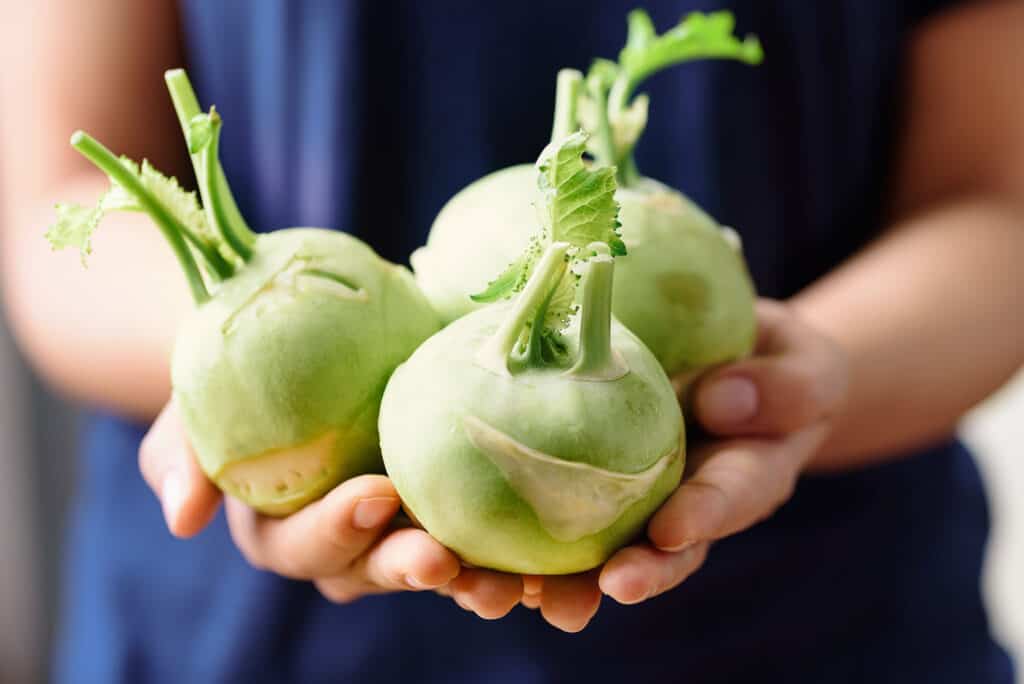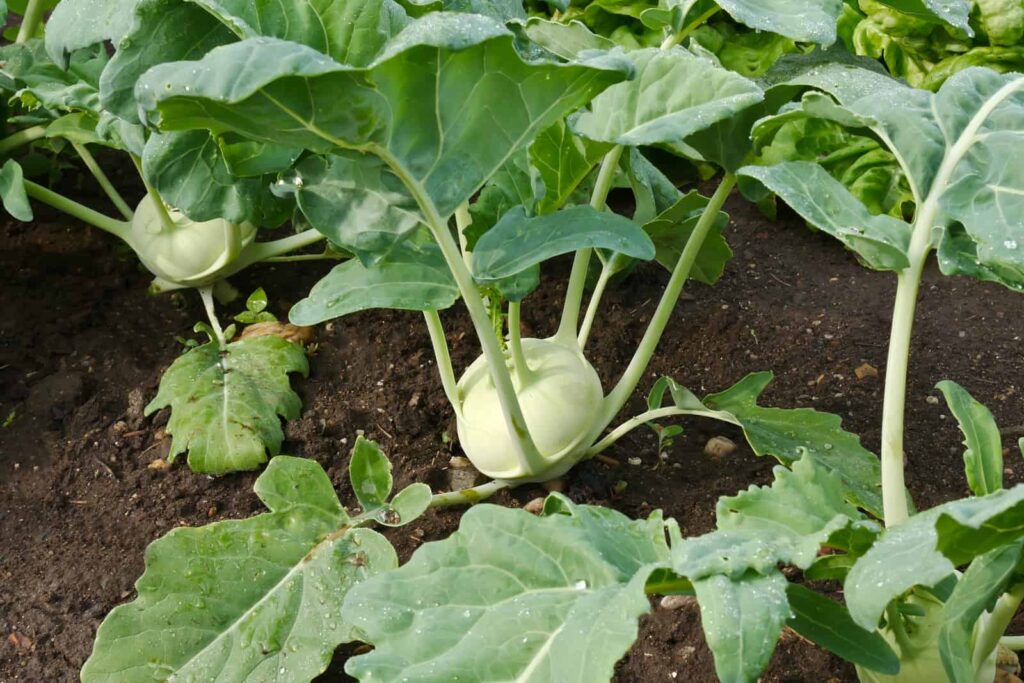Lift kohlrabi from your garden when the mid-stem bulbs swell to 2 to 3 inches in diameter. (Turnips that form bulbs below the soil are best harvested at about the same size.) Don’t let kohlrabi bulbs grow much larger or they will rapidly become woody.
Lift kohlrabi bulbs gently or cut them off just above the soil to avoid pulling up neighboring bulbs.
Kohlrabi is moderately frost-hardy, but if the weather turns freezing cold immediately protect stems and plants with cloches or fleece. Where freezing temperatures are common, do not leave kohlrabi in the garden.
Related articles:

Kohlrabi is ready for harvest 40 to 80 or more days after sowing depending on the variety.
Know the variety and days to maturity of the variety you are growing. The tastiest kohlrabi is eaten young and tender. Kohlrabi that grows too large will become woody, tough, and bitter tasting.
Kohlrabi looks like an above-ground root, but it is an enlarged stem with leaves growing out of it. Kohlrabi has the flavor of tender cabbage hearts.
When to harvest kohlrabi
- Harvest spring-planted kohlrabi when the enlarged stem is 1 to 2 inches (2.5-5 cm) in diameter.
- Harvest summer and autumn planted kohlrabi when the stem is 3 to 4 inches (7-10 cm) in diameter.
- Harvest giant kohlrabi varieties when they are 8 to 10 inches (20-25 cm) in diameter.
- Kohlrabi that ripens in mild and cool weather will be tastier than kohlrabi which matures in warm and hot weather. Where summers are cool, grow kohlrabi spring through autumn. Where summers are hot, grow kohlrabi in fall and winter.
- Kohlrabi which matures in cool weather can remain in the ground until temperatures fall into the 20°sF (-6°C). Garden-stored kohlrabi can freeze once or twice in winter and still be edible.

How to harvest kohlrabi
- Harvest a kohlrabi stem by cutting it from the base of the plant with a serrated knife. Trim the leaves from the stem before cooking or storing.
- Kohlrabi stems can be eaten raw or cooked like turnips. The leaves can be eaten raw or steamed just tender.
- Snip the leaves from the stem any time during the growing season for eating but don’t take all of the leaves so that the plant will continue to grow.

How to store kohlrabi
- Store kohlrabi cold and moist, 32°-40°F (0°-4°C) and 95 percent relative humidity. Cold and moist storage is a challenge. A refrigerator is cold but the air is dry. Place kohlrabi in a perforated plastic bag in the vegetable crisper section.
- Kohlrabi with the leaves attached will keep in the refrigerator for 2 to 4 weeks, without the leaves 2 to 3 months.
- If there is no room in the refrigerator, kohlrabi can also be packed in a container—a bucket or plastic storage box, or cooler–in moist sand or sawdust. Don’t pack stems too tightly; if the stems touch they can start to rot; be sure to leave 2 inches (5 cm) of insulating material around at the top, bottom, and sides of the stored roots. Set the lid loosely so that there is good air circulation and place the container in as cool a place as possible short of freezing such as a basement, garage, or shed.
- Check roots in storage often and remove any that show signs of deterioration. If stored stems get too warm they will sprout new tops and become woody.
Kohlrabi articles at Harvest to Table:
How to Plant and Grow Kohlrabi
How to Harvest and Store Kohlrabi
Turnip, Rutabaga, and Kohlrabi Growing Problem Troubleshooting
Ten Ways to Cook and Serve Kohlrabi
Garden Planning Books at Amazon:
- Vegetable Garden Grower’s Guide
- Tomato Grower’s Answer Book
- Vegetable Garden Almanac & Planner
- Kitchen Garden Grower’s Guide Vegetable Encyclopedia
More harvest tips:
Learn when and how to harvest your favorite vegetables for the best flavor and texture. Get storage tips for each crop. Click on the vegetable you are growing below.
- Artichoke
- Arugula
- Asparagus
- Beans
- Beets
- Broccoli
- Brussels Sprouts
- Cabbage
- Cantaloupe — Melons
- Carrots
- Cauliflower
- Celery
- Chard
- Collards
- Corn, Sweet
- Cucumbers
- Eggplant
- Endive and Escarole
- Garlic
- Jerusalem Artichoke
- Kale
- Kohlrabi
- Leeks
- Lettuce
- Melons
- Okra
- Onions
- Parsnips
- Peas
- Peppers
- Potatoes
- Pumpkins
- Radicchio
- Rhubarb
- Rutabaga
- Spinach
- Squash, Summer
- Squash, Winter
- Sunchokes
- Sweet Potato
- Swiss Chard
- Tomatillo
- Tomatoes
- Turnips
- Watermelon















